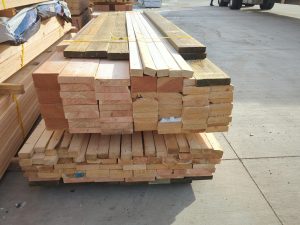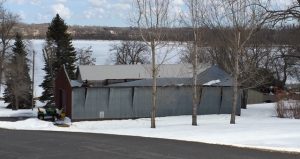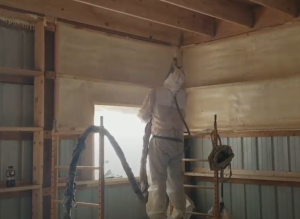Integral Condensation Control (I.C.C.) products are manufactured and distributed with trade names such as Condenstop (which I have written about previously: https://www.hansenpolebuildings.com/2014/07/condenstop/) and Dripstop.
Here are a few words on Dripstop, recorded live at the NFBA Expo held recently in Nashville, Tennessee:
I.C.C. provides drip prevention which is integral to steel roofing and is aimed at saving installation time and labor. I.C.C. is comprised of a polyester fabric with an adhesive glue layer which allows it to be adhered to the washcoat (the underside) of steel roofing panels. The fabric is attached to the sheet metal as it is being unwrapped from the coil and is roll formed with the panel, allowing the steel roofing to arrive on the jobsite ready for immediate installation.
Steel roofing with I.C.C. addresses drip prevention in a new way. By providing a wicking material to retain the moisture, condensation is no longer the enemy. This product works with the natural condensation cycle to prevent dripping and is far more durable than barriers. No additional products or inventory are necessary, and because I.C.C. is factory-applied, no additional jobsite labor is required. No need to worry about dragging around rolls of reflective or metal building insulation, just install the roof and get the job done.
To better understand how this product works, we must first discuss why condensation and dripping happen in the first place. When atmospheric conditions reach the dew point, air contains the maximum amount of moisture it can retain at its temperature. This is known as 100% relative humidity. Since cool air is unable to retain as much moisture as warm air, any drop in temperature from contact with a cooler surface essentially “wrings” the moisture out of the air. This is why fogging (condensation) is caused by the warm, moist air in our breath hitting a colder pane of glass. As the glass cools the warm, moist air contacting it, the moisture in our breath is “wrung” out.
As noted above, where warm air meets cool surfaces, the moisture in this air will often condense to the surface and form droplets. When exterior air cools steel cladding below the building’s interior temperature, the steel can provide this surface. Once condensation begins to take place, the droplets formed will combine as they contact one another, continuing to do so until they are too large to be supported by the liquid’s surface tension. At this point, dripping will occur, essentially raining on the structure’s contents.
Because some people are unaware of this process, many steel roofed post frame building owners are convinced all metal roofing leaks – a make believe ‘fact’ which can deter them from an otherwise superior product as well as cause headaches for both builders and post frame building kit package suppliers. In the past, the solution to this has been to provide a thermal break between the structure’s interior and the steel roofing to isolate the warm moist air inside the building from the underside of the cooler roof steel.
In theory, this is an excellent idea. In practice, it requires additional inventory and a large amount of additional labor. Meanwhile, the steel roofing waits to be installed. These problems are compounded by the fact barrier products are generally hard to handle and install in even mildly inclement weather.
Steel roofing with I.C.C. eliminates these delays, reduces inventory and simplifies construction without sacrificing drip-preventing performance.
The core of I.C.C. is a polyester fleece. When this material is adhered to steel panels, it greatly increases the surface area from moisture to cling to after condensing. The fleece provides hundreds of fibers per square inch for droplets to stick to, thereby greatly increasing the “grip” they have on the interior of the cladding. Because of this, a twelve foot panel can retain over half a gallon of condensed moisture.
Steel roofing with I.C.C. is well suited for a wide variety of applications. Similar products have been available for over 15 years in Europe and have provided successful service on every continent and in nearly every climate in countless applications. Steel roofing with I.C.C. is well suited for self-storage, animal confinement, garages, grain storage, car ports, barns, aircraft hangars, stadiums and literally any other place where condensation and drip prevention are of concern.
The I.C.C. fabric requires contact with air to function properly, therefore it is not recommended for closed-decking applications. Also, it is not meant to function as insulation due to its low R-value.
In closed wall applications, any edges exposed to the exterior of a structure (i.e. the eaves), should be sealed to prevent moisture from seeping into the structure through the fabric.
The additional thickness of the I.C.C. fabric changes the roll-forming characteristics of steel panels, giving panels a slight “barrel-roll”. This effect is limited to an inch of curl up at the sides when the panel lays color up on a flat surface and provides no additional challenges for installation. Another effect is the reduction of smoothness at all bends in the panel. Again, this has no effect on performance of either panel or fabric. The barrel-roll is imperceptible after installation and the bend texture is indiscernible at distances greater than an arm’s length.









